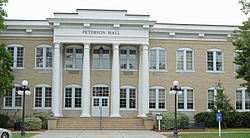Haralson Bleckley | |
|---|---|
| Born | January 31, 1870 Atlanta, Georgia |
| Died | December 5, 1933 Atlanta, Georgia |
| Resting place | Oakland Cemetery |
| Occupation | Architect |
| Spouse | Ollie Evans |
| Parent(s) | Logan Edwin Bleckley Caroline Haralson |
| Relatives | John Brown Gordon (maternal uncle) |
Haralson Bleckley (January 31, 1870 - December 5, 1933) was an American architect who designed many buildings in his hometown of Atlanta, Georgia. [1] [2] Several of his works are listed on the National Register of Historic Places (NRHP). [3] His office was in the Flatiron Building. [4] He also proposed the Bleckley Plaza Plan, a largescale architectural project that would have seen the creation of a large plaza in downtown Atlanta.
Bleckley designed the University of Georgia Library Building built in 1904. [5] He also designed the Bona Allen Mansion, built in 1911–12 in Buford, Georgia: [6] Other works include:
- Several works in Eleventh District A & M School-South Georgia College Historic District, Douglas, Georgia, NRHP-listed. [3] Including:

- Peterson Hall (1907, originally the Academic Building)
- Davis Hall (1907, a dormitory)
- Powell Hall (1907, a dormitory)
- Baptist Church (1909), Ponce de Leon Avenue, Atlanta [7]
- Fourth Ward School (1910) in Atlanta. [8]
- Griffin Hotel (1910), included in Griffin Commercial Historic District, Griffin, GA (Bleckley, Haralson), NRHP-listed [3] [9]
- Griffin Hospital and Nurses' Home (c.1910), Griffin, Georgia [10]
- Griffin City Hall [11]
- One or more works in Third District A & M School-Georgia Southwestern College Historic District, 800 Wheatley St., Americus, GA (Bleckley, Haralson), NRHP-listed [3]
- Tyree Building (1915–16), 679 Durant Pl., NE, Atlanta, GA (Bleckley, Haralson), NRHP-listed [3] [12] also included in the Midtown Historic District [13]